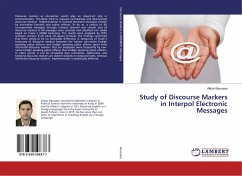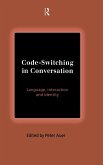Alisha Reaves
Discourse Markers in Second Language French
Alisha Reaves
Discourse Markers in Second Language French
- Gebundenes Buch
- Merkliste
- Auf die Merkliste
- Bewerten Bewerten
- Teilen
- Produkt teilen
- Produkterinnerung
- Produkterinnerung
This book provides an in-depth look at pragmatic development by second language learners of French through their production of French discourse markers. It showcases a holistic production-focused approach designed to provide a broad picture of learner discourse marker use in French.
Andere Kunden interessierten sich auch für
![Cognitive Linguistics and Second Language Learning Cognitive Linguistics and Second Language Learning]() Andrea TylerCognitive Linguistics and Second Language Learning50,99 €
Andrea TylerCognitive Linguistics and Second Language Learning50,99 €![Study of Discourse Markers in Interpol Electronic Messages Study of Discourse Markers in Interpol Electronic Messages]() Akbar MousaeeStudy of Discourse Markers in Interpol Electronic Messages33,99 €
Akbar MousaeeStudy of Discourse Markers in Interpol Electronic Messages33,99 €![A Functional Linguistic Perspective on Developing Language A Functional Linguistic Perspective on Developing Language]() Anne McCabeA Functional Linguistic Perspective on Developing Language167,99 €
Anne McCabeA Functional Linguistic Perspective on Developing Language167,99 €![Longman Dictionary of Language Teaching and Applied Linguistics Longman Dictionary of Language Teaching and Applied Linguistics]() Jack C. RichardsLongman Dictionary of Language Teaching and Applied Linguistics191,99 €
Jack C. RichardsLongman Dictionary of Language Teaching and Applied Linguistics191,99 €![Code-Switching in Conversation Code-Switching in Conversation]() Peter Auer (ed.)Code-Switching in Conversation170,99 €
Peter Auer (ed.)Code-Switching in Conversation170,99 €![Discourse Markers Discourse Markers]() Graham RangerDiscourse Markers83,99 €
Graham RangerDiscourse Markers83,99 €![Discourse Markers Discourse Markers]() Graham RangerDiscourse Markers61,99 €
Graham RangerDiscourse Markers61,99 €-
-
-
This book provides an in-depth look at pragmatic development by second language learners of French through their production of French discourse markers. It showcases a holistic production-focused approach designed to provide a broad picture of learner discourse marker use in French.
Produktdetails
- Produktdetails
- Verlag: Routledge
- Seitenzahl: 180
- Erscheinungstermin: 31. März 2023
- Englisch
- Abmessung: 235mm x 157mm x 14mm
- Gewicht: 420g
- ISBN-13: 9781032347660
- ISBN-10: 103234766X
- Artikelnr.: 66733199
- Herstellerkennzeichnung
- Libri GmbH
- Europaallee 1
- 36244 Bad Hersfeld
- gpsr@libri.de
- Verlag: Routledge
- Seitenzahl: 180
- Erscheinungstermin: 31. März 2023
- Englisch
- Abmessung: 235mm x 157mm x 14mm
- Gewicht: 420g
- ISBN-13: 9781032347660
- ISBN-10: 103234766X
- Artikelnr.: 66733199
- Herstellerkennzeichnung
- Libri GmbH
- Europaallee 1
- 36244 Bad Hersfeld
- gpsr@libri.de
Alisha Reaves is an Assistant Professor of French and Linguistics at Towson University. Her research focuses on the second language acquisition of French. Additional research areas include language and education policy and lexical variation and meaning in French.
TABLE OF CONTENTS
List of Tables
List of Figures
Acknowledgements
1. Introduction
1.1 Discourse Markers in French Society
1.2 Discourse Markers in the L2 Classroom
1.3 Learner Challenges in Acquiring Discourse Markers
1.4 Motivations for Studying L2 Discourse Marker Development
1.5 Organization of the Book
1.6 References
2. What are Discourse Markers?
2.1 Terminological Debates
2.2 Key Characteristics of Discourse Markers
2.3 What (for practical purposes) Counts as a Discourse Marker?
2.4 Discourse Markers and Position
2.5 Discourse Marker Combinations
2.6 Defining Discourse Markers for this Study
2.7 References
3. Functions of Common French Discourse Markers
3.1 Introduction
3.2 Alors
3.3 Ben
3.4 Bon
3.5 Donc
3.6 En effet
3.7 En fait
3.8 Enfin
3.9 Hein
3.10 Mais
3.11 Oui
3.12 Parce que
3.13 Puis
3.14 Quoi
3.15 Tu sais
3.16 Voilà
3.17 References
4. What Do We Already Know about L2 Discourse Marker Use?
4.1 Five Conclusions Drawn from L2 Discourse Marker Research to Date
4.2 Can L1 Transfer Explain Learner Discourse Marker Production?
4.3 What Sociolinguistic Variables Affect Discourse Marker Use in the L2?
4.4 What is the Effect of Study Abroad?
4.5 (How) Do Learners Process Discourse Markers that They Hear?
4.6 Can Discourse Markers Be Taught?
4.7 Refocusing on L2 French Discourse Markers
4.8 Conclusion
4.9 References
5. Methodological Questions in L2 Discourse Marker Research
5.1 Introduction
5.2 Contrastive or Interlanguage Analysis?
5.3 Form-to-function or function-to-form?
5.4 The Effects of Tasks and Instruments
5.5 The Current Study
5.6 Conclusion
5.7 References
6. How Do Native Speakers Use Discourse Markers?
6.1 Introduction
6.2 What is the Inventory of Discourse Markers Used by the Native Speakers
of French in this Study?
6.3 What is the Functional Distribution of Discourse Markers for Native
Speakers in this Corpus?
6.4 Syntactic Considerations
6.5 Sociolinguistic Considerations
6.6 Conclusion
6.7 References
7. How Do Learners of French use Discourse Markers?
7.1 Introduction
7.2 What is the Inventory of Discourse Markers used by Learners of French?
7.3 What is the Distribution of DM to function and How Does the Inventory
of DMs and their Functions Change over Time?
7.4 Syntactic Considerations
7.5 Sociolinguistic Considerations
7.6 Conclusion
7.7 References
8. New Insights and Next Steps in L2 Discourse Marker Research
8.1 Introduction
8.2 Primary Findings of this Study
8.3 Other Contributing Factors to L2 Discourse Marker Acquisition
8.4 What can L2 Acquisition Tell us about the Nature of Discourse Markers?
8.5 Methodological and Pedagogical Implications
8.6 References
9. Conclusion
9.1 Concluding Remarks
9.2 Future Directions
9.3 References
10. Appendices
Appendix A - Participant Profiles
Appendix B - Native Speaker Discourse Marker Inventory
Appendix C - Learner Discourse Marker Inventory
References
Index
List of Tables
List of Figures
Acknowledgements
1. Introduction
1.1 Discourse Markers in French Society
1.2 Discourse Markers in the L2 Classroom
1.3 Learner Challenges in Acquiring Discourse Markers
1.4 Motivations for Studying L2 Discourse Marker Development
1.5 Organization of the Book
1.6 References
2. What are Discourse Markers?
2.1 Terminological Debates
2.2 Key Characteristics of Discourse Markers
2.3 What (for practical purposes) Counts as a Discourse Marker?
2.4 Discourse Markers and Position
2.5 Discourse Marker Combinations
2.6 Defining Discourse Markers for this Study
2.7 References
3. Functions of Common French Discourse Markers
3.1 Introduction
3.2 Alors
3.3 Ben
3.4 Bon
3.5 Donc
3.6 En effet
3.7 En fait
3.8 Enfin
3.9 Hein
3.10 Mais
3.11 Oui
3.12 Parce que
3.13 Puis
3.14 Quoi
3.15 Tu sais
3.16 Voilà
3.17 References
4. What Do We Already Know about L2 Discourse Marker Use?
4.1 Five Conclusions Drawn from L2 Discourse Marker Research to Date
4.2 Can L1 Transfer Explain Learner Discourse Marker Production?
4.3 What Sociolinguistic Variables Affect Discourse Marker Use in the L2?
4.4 What is the Effect of Study Abroad?
4.5 (How) Do Learners Process Discourse Markers that They Hear?
4.6 Can Discourse Markers Be Taught?
4.7 Refocusing on L2 French Discourse Markers
4.8 Conclusion
4.9 References
5. Methodological Questions in L2 Discourse Marker Research
5.1 Introduction
5.2 Contrastive or Interlanguage Analysis?
5.3 Form-to-function or function-to-form?
5.4 The Effects of Tasks and Instruments
5.5 The Current Study
5.6 Conclusion
5.7 References
6. How Do Native Speakers Use Discourse Markers?
6.1 Introduction
6.2 What is the Inventory of Discourse Markers Used by the Native Speakers
of French in this Study?
6.3 What is the Functional Distribution of Discourse Markers for Native
Speakers in this Corpus?
6.4 Syntactic Considerations
6.5 Sociolinguistic Considerations
6.6 Conclusion
6.7 References
7. How Do Learners of French use Discourse Markers?
7.1 Introduction
7.2 What is the Inventory of Discourse Markers used by Learners of French?
7.3 What is the Distribution of DM to function and How Does the Inventory
of DMs and their Functions Change over Time?
7.4 Syntactic Considerations
7.5 Sociolinguistic Considerations
7.6 Conclusion
7.7 References
8. New Insights and Next Steps in L2 Discourse Marker Research
8.1 Introduction
8.2 Primary Findings of this Study
8.3 Other Contributing Factors to L2 Discourse Marker Acquisition
8.4 What can L2 Acquisition Tell us about the Nature of Discourse Markers?
8.5 Methodological and Pedagogical Implications
8.6 References
9. Conclusion
9.1 Concluding Remarks
9.2 Future Directions
9.3 References
10. Appendices
Appendix A - Participant Profiles
Appendix B - Native Speaker Discourse Marker Inventory
Appendix C - Learner Discourse Marker Inventory
References
Index
TABLE OF CONTENTS
List of Tables
List of Figures
Acknowledgements
1. Introduction
1.1 Discourse Markers in French Society
1.2 Discourse Markers in the L2 Classroom
1.3 Learner Challenges in Acquiring Discourse Markers
1.4 Motivations for Studying L2 Discourse Marker Development
1.5 Organization of the Book
1.6 References
2. What are Discourse Markers?
2.1 Terminological Debates
2.2 Key Characteristics of Discourse Markers
2.3 What (for practical purposes) Counts as a Discourse Marker?
2.4 Discourse Markers and Position
2.5 Discourse Marker Combinations
2.6 Defining Discourse Markers for this Study
2.7 References
3. Functions of Common French Discourse Markers
3.1 Introduction
3.2 Alors
3.3 Ben
3.4 Bon
3.5 Donc
3.6 En effet
3.7 En fait
3.8 Enfin
3.9 Hein
3.10 Mais
3.11 Oui
3.12 Parce que
3.13 Puis
3.14 Quoi
3.15 Tu sais
3.16 Voilà
3.17 References
4. What Do We Already Know about L2 Discourse Marker Use?
4.1 Five Conclusions Drawn from L2 Discourse Marker Research to Date
4.2 Can L1 Transfer Explain Learner Discourse Marker Production?
4.3 What Sociolinguistic Variables Affect Discourse Marker Use in the L2?
4.4 What is the Effect of Study Abroad?
4.5 (How) Do Learners Process Discourse Markers that They Hear?
4.6 Can Discourse Markers Be Taught?
4.7 Refocusing on L2 French Discourse Markers
4.8 Conclusion
4.9 References
5. Methodological Questions in L2 Discourse Marker Research
5.1 Introduction
5.2 Contrastive or Interlanguage Analysis?
5.3 Form-to-function or function-to-form?
5.4 The Effects of Tasks and Instruments
5.5 The Current Study
5.6 Conclusion
5.7 References
6. How Do Native Speakers Use Discourse Markers?
6.1 Introduction
6.2 What is the Inventory of Discourse Markers Used by the Native Speakers of French in this Study?
6.3 What is the Functional Distribution of Discourse Markers for Native Speakers in this Corpus?
6.4 Syntactic Considerations
6.5 Sociolinguistic Considerations
6.6 Conclusion
6.7 References
7. How Do Learners of French use Discourse Markers?
7.1 Introduction
7.2 What is the Inventory of Discourse Markers used by Learners of French?
7.3 What is the Distribution of DM to function and How Does the Inventory of DMs and their Functions Change over Time?
7.4 Syntactic Considerations
7.5 Sociolinguistic Considerations
7.6 Conclusion
7.7 References
8. New Insights and Next Steps in L2 Discourse Marker Research
8.1 Introduction
8.2 Primary Findings of this Study
8.3 Other Contributing Factors to L2 Discourse Marker Acquisition
8.4 What can L2 Acquisition Tell us about the Nature of Discourse Markers?
8.5 Methodological and Pedagogical Implications
8.6 References
9. Conclusion
9.1 Concluding Remarks
9.2 Future Directions
9.3 References
10. Appendices
Appendix A - Participant Profiles
Appendix B - Native Speaker Discourse Marker Inventory
Appendix C - Learner Discourse Marker Inventory
References
Index
List of Tables
List of Figures
Acknowledgements
1. Introduction
1.1 Discourse Markers in French Society
1.2 Discourse Markers in the L2 Classroom
1.3 Learner Challenges in Acquiring Discourse Markers
1.4 Motivations for Studying L2 Discourse Marker Development
1.5 Organization of the Book
1.6 References
2. What are Discourse Markers?
2.1 Terminological Debates
2.2 Key Characteristics of Discourse Markers
2.3 What (for practical purposes) Counts as a Discourse Marker?
2.4 Discourse Markers and Position
2.5 Discourse Marker Combinations
2.6 Defining Discourse Markers for this Study
2.7 References
3. Functions of Common French Discourse Markers
3.1 Introduction
3.2 Alors
3.3 Ben
3.4 Bon
3.5 Donc
3.6 En effet
3.7 En fait
3.8 Enfin
3.9 Hein
3.10 Mais
3.11 Oui
3.12 Parce que
3.13 Puis
3.14 Quoi
3.15 Tu sais
3.16 Voilà
3.17 References
4. What Do We Already Know about L2 Discourse Marker Use?
4.1 Five Conclusions Drawn from L2 Discourse Marker Research to Date
4.2 Can L1 Transfer Explain Learner Discourse Marker Production?
4.3 What Sociolinguistic Variables Affect Discourse Marker Use in the L2?
4.4 What is the Effect of Study Abroad?
4.5 (How) Do Learners Process Discourse Markers that They Hear?
4.6 Can Discourse Markers Be Taught?
4.7 Refocusing on L2 French Discourse Markers
4.8 Conclusion
4.9 References
5. Methodological Questions in L2 Discourse Marker Research
5.1 Introduction
5.2 Contrastive or Interlanguage Analysis?
5.3 Form-to-function or function-to-form?
5.4 The Effects of Tasks and Instruments
5.5 The Current Study
5.6 Conclusion
5.7 References
6. How Do Native Speakers Use Discourse Markers?
6.1 Introduction
6.2 What is the Inventory of Discourse Markers Used by the Native Speakers of French in this Study?
6.3 What is the Functional Distribution of Discourse Markers for Native Speakers in this Corpus?
6.4 Syntactic Considerations
6.5 Sociolinguistic Considerations
6.6 Conclusion
6.7 References
7. How Do Learners of French use Discourse Markers?
7.1 Introduction
7.2 What is the Inventory of Discourse Markers used by Learners of French?
7.3 What is the Distribution of DM to function and How Does the Inventory of DMs and their Functions Change over Time?
7.4 Syntactic Considerations
7.5 Sociolinguistic Considerations
7.6 Conclusion
7.7 References
8. New Insights and Next Steps in L2 Discourse Marker Research
8.1 Introduction
8.2 Primary Findings of this Study
8.3 Other Contributing Factors to L2 Discourse Marker Acquisition
8.4 What can L2 Acquisition Tell us about the Nature of Discourse Markers?
8.5 Methodological and Pedagogical Implications
8.6 References
9. Conclusion
9.1 Concluding Remarks
9.2 Future Directions
9.3 References
10. Appendices
Appendix A - Participant Profiles
Appendix B - Native Speaker Discourse Marker Inventory
Appendix C - Learner Discourse Marker Inventory
References
Index
TABLE OF CONTENTS
List of Tables
List of Figures
Acknowledgements
1. Introduction
1.1 Discourse Markers in French Society
1.2 Discourse Markers in the L2 Classroom
1.3 Learner Challenges in Acquiring Discourse Markers
1.4 Motivations for Studying L2 Discourse Marker Development
1.5 Organization of the Book
1.6 References
2. What are Discourse Markers?
2.1 Terminological Debates
2.2 Key Characteristics of Discourse Markers
2.3 What (for practical purposes) Counts as a Discourse Marker?
2.4 Discourse Markers and Position
2.5 Discourse Marker Combinations
2.6 Defining Discourse Markers for this Study
2.7 References
3. Functions of Common French Discourse Markers
3.1 Introduction
3.2 Alors
3.3 Ben
3.4 Bon
3.5 Donc
3.6 En effet
3.7 En fait
3.8 Enfin
3.9 Hein
3.10 Mais
3.11 Oui
3.12 Parce que
3.13 Puis
3.14 Quoi
3.15 Tu sais
3.16 Voilà
3.17 References
4. What Do We Already Know about L2 Discourse Marker Use?
4.1 Five Conclusions Drawn from L2 Discourse Marker Research to Date
4.2 Can L1 Transfer Explain Learner Discourse Marker Production?
4.3 What Sociolinguistic Variables Affect Discourse Marker Use in the L2?
4.4 What is the Effect of Study Abroad?
4.5 (How) Do Learners Process Discourse Markers that They Hear?
4.6 Can Discourse Markers Be Taught?
4.7 Refocusing on L2 French Discourse Markers
4.8 Conclusion
4.9 References
5. Methodological Questions in L2 Discourse Marker Research
5.1 Introduction
5.2 Contrastive or Interlanguage Analysis?
5.3 Form-to-function or function-to-form?
5.4 The Effects of Tasks and Instruments
5.5 The Current Study
5.6 Conclusion
5.7 References
6. How Do Native Speakers Use Discourse Markers?
6.1 Introduction
6.2 What is the Inventory of Discourse Markers Used by the Native Speakers
of French in this Study?
6.3 What is the Functional Distribution of Discourse Markers for Native
Speakers in this Corpus?
6.4 Syntactic Considerations
6.5 Sociolinguistic Considerations
6.6 Conclusion
6.7 References
7. How Do Learners of French use Discourse Markers?
7.1 Introduction
7.2 What is the Inventory of Discourse Markers used by Learners of French?
7.3 What is the Distribution of DM to function and How Does the Inventory
of DMs and their Functions Change over Time?
7.4 Syntactic Considerations
7.5 Sociolinguistic Considerations
7.6 Conclusion
7.7 References
8. New Insights and Next Steps in L2 Discourse Marker Research
8.1 Introduction
8.2 Primary Findings of this Study
8.3 Other Contributing Factors to L2 Discourse Marker Acquisition
8.4 What can L2 Acquisition Tell us about the Nature of Discourse Markers?
8.5 Methodological and Pedagogical Implications
8.6 References
9. Conclusion
9.1 Concluding Remarks
9.2 Future Directions
9.3 References
10. Appendices
Appendix A - Participant Profiles
Appendix B - Native Speaker Discourse Marker Inventory
Appendix C - Learner Discourse Marker Inventory
References
Index
List of Tables
List of Figures
Acknowledgements
1. Introduction
1.1 Discourse Markers in French Society
1.2 Discourse Markers in the L2 Classroom
1.3 Learner Challenges in Acquiring Discourse Markers
1.4 Motivations for Studying L2 Discourse Marker Development
1.5 Organization of the Book
1.6 References
2. What are Discourse Markers?
2.1 Terminological Debates
2.2 Key Characteristics of Discourse Markers
2.3 What (for practical purposes) Counts as a Discourse Marker?
2.4 Discourse Markers and Position
2.5 Discourse Marker Combinations
2.6 Defining Discourse Markers for this Study
2.7 References
3. Functions of Common French Discourse Markers
3.1 Introduction
3.2 Alors
3.3 Ben
3.4 Bon
3.5 Donc
3.6 En effet
3.7 En fait
3.8 Enfin
3.9 Hein
3.10 Mais
3.11 Oui
3.12 Parce que
3.13 Puis
3.14 Quoi
3.15 Tu sais
3.16 Voilà
3.17 References
4. What Do We Already Know about L2 Discourse Marker Use?
4.1 Five Conclusions Drawn from L2 Discourse Marker Research to Date
4.2 Can L1 Transfer Explain Learner Discourse Marker Production?
4.3 What Sociolinguistic Variables Affect Discourse Marker Use in the L2?
4.4 What is the Effect of Study Abroad?
4.5 (How) Do Learners Process Discourse Markers that They Hear?
4.6 Can Discourse Markers Be Taught?
4.7 Refocusing on L2 French Discourse Markers
4.8 Conclusion
4.9 References
5. Methodological Questions in L2 Discourse Marker Research
5.1 Introduction
5.2 Contrastive or Interlanguage Analysis?
5.3 Form-to-function or function-to-form?
5.4 The Effects of Tasks and Instruments
5.5 The Current Study
5.6 Conclusion
5.7 References
6. How Do Native Speakers Use Discourse Markers?
6.1 Introduction
6.2 What is the Inventory of Discourse Markers Used by the Native Speakers
of French in this Study?
6.3 What is the Functional Distribution of Discourse Markers for Native
Speakers in this Corpus?
6.4 Syntactic Considerations
6.5 Sociolinguistic Considerations
6.6 Conclusion
6.7 References
7. How Do Learners of French use Discourse Markers?
7.1 Introduction
7.2 What is the Inventory of Discourse Markers used by Learners of French?
7.3 What is the Distribution of DM to function and How Does the Inventory
of DMs and their Functions Change over Time?
7.4 Syntactic Considerations
7.5 Sociolinguistic Considerations
7.6 Conclusion
7.7 References
8. New Insights and Next Steps in L2 Discourse Marker Research
8.1 Introduction
8.2 Primary Findings of this Study
8.3 Other Contributing Factors to L2 Discourse Marker Acquisition
8.4 What can L2 Acquisition Tell us about the Nature of Discourse Markers?
8.5 Methodological and Pedagogical Implications
8.6 References
9. Conclusion
9.1 Concluding Remarks
9.2 Future Directions
9.3 References
10. Appendices
Appendix A - Participant Profiles
Appendix B - Native Speaker Discourse Marker Inventory
Appendix C - Learner Discourse Marker Inventory
References
Index
TABLE OF CONTENTS
List of Tables
List of Figures
Acknowledgements
1. Introduction
1.1 Discourse Markers in French Society
1.2 Discourse Markers in the L2 Classroom
1.3 Learner Challenges in Acquiring Discourse Markers
1.4 Motivations for Studying L2 Discourse Marker Development
1.5 Organization of the Book
1.6 References
2. What are Discourse Markers?
2.1 Terminological Debates
2.2 Key Characteristics of Discourse Markers
2.3 What (for practical purposes) Counts as a Discourse Marker?
2.4 Discourse Markers and Position
2.5 Discourse Marker Combinations
2.6 Defining Discourse Markers for this Study
2.7 References
3. Functions of Common French Discourse Markers
3.1 Introduction
3.2 Alors
3.3 Ben
3.4 Bon
3.5 Donc
3.6 En effet
3.7 En fait
3.8 Enfin
3.9 Hein
3.10 Mais
3.11 Oui
3.12 Parce que
3.13 Puis
3.14 Quoi
3.15 Tu sais
3.16 Voilà
3.17 References
4. What Do We Already Know about L2 Discourse Marker Use?
4.1 Five Conclusions Drawn from L2 Discourse Marker Research to Date
4.2 Can L1 Transfer Explain Learner Discourse Marker Production?
4.3 What Sociolinguistic Variables Affect Discourse Marker Use in the L2?
4.4 What is the Effect of Study Abroad?
4.5 (How) Do Learners Process Discourse Markers that They Hear?
4.6 Can Discourse Markers Be Taught?
4.7 Refocusing on L2 French Discourse Markers
4.8 Conclusion
4.9 References
5. Methodological Questions in L2 Discourse Marker Research
5.1 Introduction
5.2 Contrastive or Interlanguage Analysis?
5.3 Form-to-function or function-to-form?
5.4 The Effects of Tasks and Instruments
5.5 The Current Study
5.6 Conclusion
5.7 References
6. How Do Native Speakers Use Discourse Markers?
6.1 Introduction
6.2 What is the Inventory of Discourse Markers Used by the Native Speakers of French in this Study?
6.3 What is the Functional Distribution of Discourse Markers for Native Speakers in this Corpus?
6.4 Syntactic Considerations
6.5 Sociolinguistic Considerations
6.6 Conclusion
6.7 References
7. How Do Learners of French use Discourse Markers?
7.1 Introduction
7.2 What is the Inventory of Discourse Markers used by Learners of French?
7.3 What is the Distribution of DM to function and How Does the Inventory of DMs and their Functions Change over Time?
7.4 Syntactic Considerations
7.5 Sociolinguistic Considerations
7.6 Conclusion
7.7 References
8. New Insights and Next Steps in L2 Discourse Marker Research
8.1 Introduction
8.2 Primary Findings of this Study
8.3 Other Contributing Factors to L2 Discourse Marker Acquisition
8.4 What can L2 Acquisition Tell us about the Nature of Discourse Markers?
8.5 Methodological and Pedagogical Implications
8.6 References
9. Conclusion
9.1 Concluding Remarks
9.2 Future Directions
9.3 References
10. Appendices
Appendix A - Participant Profiles
Appendix B - Native Speaker Discourse Marker Inventory
Appendix C - Learner Discourse Marker Inventory
References
Index
List of Tables
List of Figures
Acknowledgements
1. Introduction
1.1 Discourse Markers in French Society
1.2 Discourse Markers in the L2 Classroom
1.3 Learner Challenges in Acquiring Discourse Markers
1.4 Motivations for Studying L2 Discourse Marker Development
1.5 Organization of the Book
1.6 References
2. What are Discourse Markers?
2.1 Terminological Debates
2.2 Key Characteristics of Discourse Markers
2.3 What (for practical purposes) Counts as a Discourse Marker?
2.4 Discourse Markers and Position
2.5 Discourse Marker Combinations
2.6 Defining Discourse Markers for this Study
2.7 References
3. Functions of Common French Discourse Markers
3.1 Introduction
3.2 Alors
3.3 Ben
3.4 Bon
3.5 Donc
3.6 En effet
3.7 En fait
3.8 Enfin
3.9 Hein
3.10 Mais
3.11 Oui
3.12 Parce que
3.13 Puis
3.14 Quoi
3.15 Tu sais
3.16 Voilà
3.17 References
4. What Do We Already Know about L2 Discourse Marker Use?
4.1 Five Conclusions Drawn from L2 Discourse Marker Research to Date
4.2 Can L1 Transfer Explain Learner Discourse Marker Production?
4.3 What Sociolinguistic Variables Affect Discourse Marker Use in the L2?
4.4 What is the Effect of Study Abroad?
4.5 (How) Do Learners Process Discourse Markers that They Hear?
4.6 Can Discourse Markers Be Taught?
4.7 Refocusing on L2 French Discourse Markers
4.8 Conclusion
4.9 References
5. Methodological Questions in L2 Discourse Marker Research
5.1 Introduction
5.2 Contrastive or Interlanguage Analysis?
5.3 Form-to-function or function-to-form?
5.4 The Effects of Tasks and Instruments
5.5 The Current Study
5.6 Conclusion
5.7 References
6. How Do Native Speakers Use Discourse Markers?
6.1 Introduction
6.2 What is the Inventory of Discourse Markers Used by the Native Speakers of French in this Study?
6.3 What is the Functional Distribution of Discourse Markers for Native Speakers in this Corpus?
6.4 Syntactic Considerations
6.5 Sociolinguistic Considerations
6.6 Conclusion
6.7 References
7. How Do Learners of French use Discourse Markers?
7.1 Introduction
7.2 What is the Inventory of Discourse Markers used by Learners of French?
7.3 What is the Distribution of DM to function and How Does the Inventory of DMs and their Functions Change over Time?
7.4 Syntactic Considerations
7.5 Sociolinguistic Considerations
7.6 Conclusion
7.7 References
8. New Insights and Next Steps in L2 Discourse Marker Research
8.1 Introduction
8.2 Primary Findings of this Study
8.3 Other Contributing Factors to L2 Discourse Marker Acquisition
8.4 What can L2 Acquisition Tell us about the Nature of Discourse Markers?
8.5 Methodological and Pedagogical Implications
8.6 References
9. Conclusion
9.1 Concluding Remarks
9.2 Future Directions
9.3 References
10. Appendices
Appendix A - Participant Profiles
Appendix B - Native Speaker Discourse Marker Inventory
Appendix C - Learner Discourse Marker Inventory
References
Index








